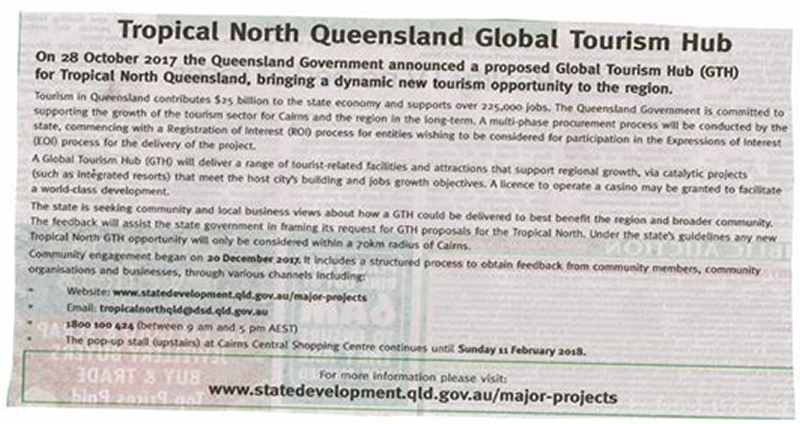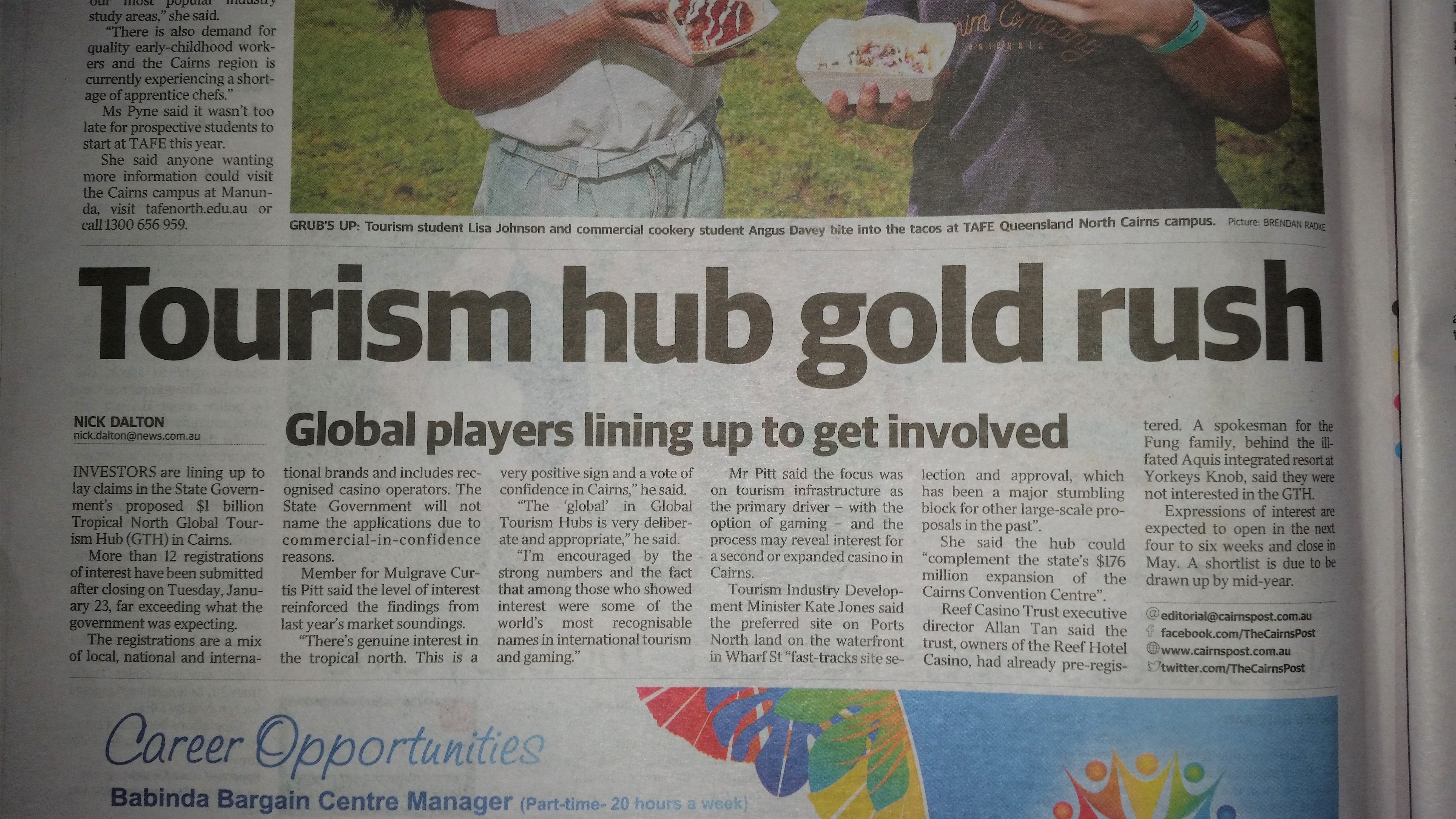DATE: 27 February 2018
TO:
Department of State Development, Manufacturing, Infrastructure and Planning
tropicalnorthqld@dsd.qld.gov.au
Treasurer and Minister for Trade and Investment: 10 Feb 2017 – 11 Dec 2017
Curtis Pitt – Mulgrave@parliament.qld.gov.au
Minister for Innovation and Tourism Industry Development and Minister for the Commonwealth Games: 12 Dec 2017
Kate Jones – cooper@parliament.qld.gov.au, tourism@ministerial.qld.gov.au, innovation@ministerial.qld.gov.au
Minister for State Development, Manufacturing, Infrastructure and Planning: 12 Dec 2017
Dick Cameron – Woodridge@parliament.qld.gov.au, statedevelopment@ministerial.qld.gov.au
Member for Barron River, Minister for Fire and Emergency Services: 12 Dec 2017
Craig Crawford Barron.River@parliament.qld.gov.au
Queensland Office Coordinator General – KUR-World Integrated “eco” Resort
kur-world@coordinatorgeneral.qld.gov.au
—
CC: Mareeba Shire Council info@msc.qld.gov.au
SOURCE: MEDIA STATEMENT Kate Jones MP: Global Tourism Hub a step closer for North Queensland
RE: Tropical North Queensland Global Tourism Hub (GTH) – Expressions of interest
Kur-Alert Inc. is a non-for-profit association that has formed in response to unsustainable planning proposals within our community of Kuranda. In particular the monster Kur-World Integrated development on the historically zoned Rural property called “Barnwell”..
The region is home to EPBC 49 Threatened species and 23 Migratory species1. The Kur-World property must be retired to Rainforest Recovery (as we have been working for 20+ years with revegetation projects) – not chopped up into little pieces and sold off on the International market.
The subject property was purchased by Ken Lee (Reever & Ocean Pty Ltd) in January 2014. Ken Lee engaged contractors Stuart Ricketts (Urban Sync) and Simon Danielsen (Astrebla Ecology Consulting) to undertake land preparation including illegal land clearing, and at least three (3) major earthwork sites on the property. All work was conducted without appropriate permits, engineer surveys and sediment and erosion control. By December 2015, complaints from adjoining residents and local environmental groups (reporting sediment moving through endangered frog species rainforest creeks), instigated a site visit from Mareeba Shire Council. A stop work was ordered at that time.
| LEGAL ADVICE Since 2015, a number of documented breaches of planning, environment and building laws have occurred on the former Barnwell Estate. The breaches include the construction of a large dam without a permit; unlawful removal of native vegetation and building work on the house without a permit. The Mareeba Shire Council either retrospectively approved these unlawful works or ignored them. The Council and State and Federal environment departments have failed to explain to the community what their enforcement policies are and why they have all failed to protect the community and the environment from these repeated breaches.Regrettably, the carrying out of the unlawful dam, building and vegetation removal works puts the proponent of the KUR-World co-ordinated project at an unfair advantage in relation to the EIS process. This is because the baseline from which the EIS is done has shifted from what it would have been before the unlawful works. The disadvantage falls to this concerned community and our unique wet tropics wildlife.Tania Heber, Principal Solicitor – Environmental Defenders Office of Northern Queensland SOURCE: http://kurandaregion.org/kur-world-developers-successive-legal-breaches-make-his-eco-resort-claims-even-more-dubious/ |
The paper trail has not kept up with the first-time developer’s illusion that he was a cattleman when he cleared the land in cahoots with local machine operators. His intention to develop the land is on the record. Google Earth demonstrates the timeline for the illegal works on the property.
The proponent failed to include the necessary ‘community engagement’ section in the EPBC Referral of proposed action’ (July 2016) – yet managed to undertake commercial reports on all other section headers.
The Environmental Impact Statement being prepared by the proponent falls short of adequate community engagement – we know because there has been no public forum initiated by the proponent for residents and landowners to be heard, on neutral ground. Our Mayor Tom Gilmore will go on the record (has multiple times) to say he thinks proponent Ken Lee is a genius – yet continuously and hopelessly fails to actually represent the real views of the community this project will actually affect.
All the promises of ‘jobs and growth’ do not wash with this community. We will refuse to be the ‘jobs and growth’ martyr for TNQ – at the expense of essential cassowary country – and environmental devastation that will be wrought with roads, concrete and steel in the Myola Valley – accelerating land clearing for more and more development in the coming decades. More people directly equates to increased threats to native endangered species through deforestation, vehicle strikes and roaming domestic predators (pet dogs and cats).
Our community residents are historically very environmentally aware of the importance of maintaining the ecological forest corridor. We fought the same battle 10 years ago to save the Myola Valley from urbanisation. We won. Our position is strongly supported by science.
| JCU Distinguished Professor Bill Laurance attended our public STOP KUR-WORLD fundraiser in July 2017 and spoke of the broader global issues of deforestation (his specialty!) and the Myola Valley specifically:
“On the Australian continent, we’re talking about 1,000th of Australia’s continental land area. A major analysis which looked at the biogeographic and the biological uniqueness and irreplaceability of different ecosystems on the planet – this was over 173,000 different protected areas on the planet – ranked the Wet Tropics World Heritage Area as the 6th most critical and irreplaceable. Of World Heritage Areas, it was the 2nd most critical and irreplaceable. I think this gives you global perspective on what we’re talking about here. Anybody, from anywhere on the planet, looking around would say this is absolutely critical biological and environmental real estate. You would not want to risk it – from an International, from a global perspective – for lots of different reasons.” SOURCE: https://youtu.be/I9aruVklZJA WIKIPEDIA: https://en.wikipedia.org/wiki/William_F._Laurance Email: bill.laurance@jcu.edu.au | Phone: +61 7 423 21819 | Location: Cairns |
| JCU Dr Conrad Hoskin summarises how precarious the endemic critically endangered Litoria myola Kuranda Tree Frog’s situation is. ABC FAR NORTH interview regarding the Kuranda Tree Frog Action Plan:
“An example of a very localised species that’s unique to the Kuranda area – where basically the fate of that species falls in the hands of all the residents and everyone in that area.” SOURCE: https://youtu.be/HkBW1E_BcrY Email: conrad.hoskin@jcu.edu.au | Phone: +61 7 478 16048 | Location: Townsville |
We urge you to speak with the SCIENTISTS – not the dealmakers. It would be a huge mistake to allow any development in the ecologically sensitive Myola Valley – for the whole World Heritage Wet Tropics Bioregion. The Myola Valley and Kuranda is in the “pinch-point” of the bioregion – a narrow band of forest less than 7km wide. Developing the Myola Valley will cut the bioregion in half above the Barron Falls.
Wet Tropics data tells us the endangered cassowary has only 20-25% of former habitat remaining – the rest is gone. In less than 100 years we have cleared up to 80% of cassowary habitat. Astounding isn’t it? Cassowary is a keystone species of the bioregion – sole disperser of at least 70 rainforest tree and plant species. Where does that put the future of the bioregion? Ask the experts! See contact details.
| Jax Bergersen from local organisation Kuranda Conservation Community Nursery – long time Kuranda local and ‘Cassowary Custodian’ in our region was interviewed to ask what damage high-density real estate subdivisions will do to fragmented essential cassowary habitat (endangered, only 20-25% of former habitat remaining < 100 years)
What will intensifying development in Kuranda Region mean for the current population of cassowary that live here? “If it’s development as we’ve always done it. It means the end of the line.” “One of the things that’s got to change in our town planning is this ten year rule that there was something that was okay ten years ago and if you get in by the 31 July – you can still do that.” “No. The reason that the plan had changed ten years ago – and you can’t do it anymore – is because it’s no longer appropriate. That we’ve woken up to ourselves. That we can’t do this anymore.” SOURCE: https://youtu.be/8Z5S2WYe5D4 Email: envirojax@gmail.com | Phone: +61 7 4093 8834 | Location: Kuranda |
We have initiated a conservation option for the Barnwell property. We are working to constrain any development and further reckless environmental damage by the developer until we can bring this land into conservation.
http://kurandaregion.org/kuranda-conservation-rainforest-trust-application
It is absurd to go along with the story that Kuranda somehow needs KUR-World or the associated high-density residential real estate LOTS. There is no demonstrated need for development of the Myola Valley (FNQ2031). There is a long list of valid scientific reasons why development must not happen in the Myola Valley. Why risk it?
The placement of an Integrated development in the Myola Valley, Kuranda is unnecessary and indicates poor planning.
Thank you for your understanding and consideration.
We look forward to your acknowledgement and response.
Kind regards,
Steven Nowakowski
Kur-Alert Inc
1 EPBC Act, Matters of National Environment Significance, within 10km of SITE, -16.828320, 145.600551 http://kurandaregion.org/content/uploads/2017/11/BARNWELL-10KM-EPBC-Matters-of-National-Environmental-Significance-PMST_VJFPG0.pdf



